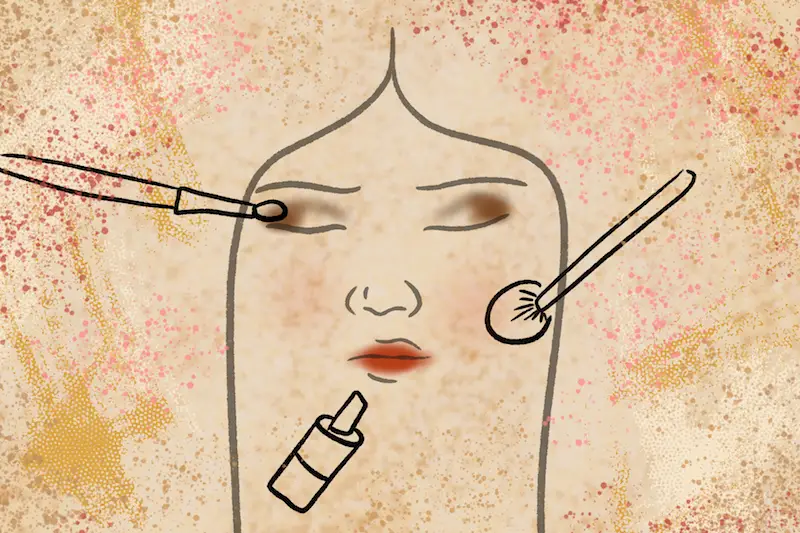If you’ve seen former SNSD member Jessica Jung’s makeup routine shot by Vogue, you’d see that it isn’t really so much about the makeup. Absent are the harsh bronzers, the highly pigmented eyeshadows, the layers upon layers of foundation. It’s about dabbing minimal foundation on already-perfect skin. Comments read along the lines of “she doesn’t even need a drop of that foundation,” or, “concealer who?”
And so it goes that the idea of already-perfect skin has gained major traction in the West. As more and more Gen Zs consume Korean media, it’s not surprising that the Western world has become enamored with Korean skincare, which promises a healthy-looking, almost translucent glow. Such a promise almost seems to justify a pricey 12-step regimen — almost.
The Korean cultural emphasis on appearance and the association of beauty with competitive career success are both driving forces behind the domestic Korean skincare industry. This skincare fixation is not surprising in a nation where hiring practices often entail potential employees attaching a photo to their application, despite President Moon Jae-in’s move toward “blind hiring.” Skincare is where the money is, and Western buyers are continuing to add fuel to that fire. In 2018, the global K-beauty market was valued at $9.3 billion, and is expected to reach $21.8 billion by 2026.
But the Korean skincare industry reflects a larger reality that consumers must contend with, which is the trendy, transient nature of market goods in South Korea. On the streets of Seoul, trends don’t usually stick around for long, and the same goes for any skincare product that appears on the shelves of any major Korean skincare and cosmetic giant — including stores like Etude House, innisfree, Skinfood, Missha, The Face Shop and Dr. Jart+.
Also, Korean dietary trends tend to become integrated into their skincare. At a certain point last year, sweet potatoes were everywhere. You could have a sweet potato pancake, a sweet potato latte and … a sweet potato face cream. (The sweet potato latte was actually pretty good, but I was shocked to see that face cream.) Although Korean skincare has been lauded in the West for being “innovative,” the sweet potato-infused face spray seems more like a bold-faced money-grab than a genuine attempt to create something effective and timeless.
But despite the fanfare around East Asian skincare and the tantalizing dream of clear skin, the industry doesn’t cater to consumers who want to find what works for them, then move on with life and only think about buying something else when they run out of product. By keeping the product lines constantly in flux, the South Korean skincare industry almost forces the consumer to pay attention, to buy something else or to try something new. By discontinuing lines, they tell the customers “Pay attention! Buy more things!” And I don’t want to pay attention, or buy new things. In 2019, Korean skincare YouTuber olgatoja made a video titled “Is It Time To Quit Korean Cosmetics?” in which she explained that after years of experimenting with Korean skincare, she had accumulated a massive amount of products that she just didn’t need, illustrating the possible addictiveness of the Korean skincare marketing strategy.
Even in the Western world, the value placed on skincare is incredibly widespread at this point, and increasingly gender-neutral. Perhaps in the United States, it’s less about getting hired and more about self-care, but the pull toward foam cleansers and sheet masks is still there. In the U.S., where trend-consciousness isn’t nearly as widespread, it seems that people just want something reliable — something that will always be in stock. And that is where Japanese skincare may be a more viable alternative to the Korean skincare craze.
Both Korean skincare and Japanese skincare have the same general goals: Both strive for hydration, as well as protection from the damaging effects of pollution and UV rays. According to skincare expert and beauty chemist David Pollock, “Japanese skincare is more reserved (compared to Korean skincare). While considered innovative and science-driven, J-beauty is more about functionality and simplicity with long-term results.” And that simplicity is the key.
Japanese skincare just isn’t as involved as the famed 10-step Korean skincare. When considered on a practical level, a full Korean skincare routine is undoubtedly difficult to maintain for busy college students. Oil cleanser, foam cleanser, exfoliator, toner, essence, serum, sheet mask, eye cream, sleeping mask — the full Korean skincare package seems excessive, as if the skincare industry is vying to find just one more step, one more scientifically-justifiable excuse for a big price tag. And, realistically, it is excessive, especially when a simpler, more straightforward (and more cost-efficient) Japanese skincare regimen has pretty much the exact same “glass skin” effect.
But also, it can be frustrating to constantly have to stray into unknown territory just to maintain some semblance of continuity. Although some people like to make skincare into a kind of hobby, I think I am in the majority when I say that once I find something that works, I’ll go back again and again. Because at the end of the day, I have to choose what holds my focus, what deserves my money and attention and concern, and constantly chasing the next-big-thing or the next famed cure-all becomes tiring, unfulfilling, and a quest to endure as many allergic reactions as possible. In this sense, consistency is better than constantly striving to find replacements and treating my skin like a never-ending science experiment.
Japanese skincare, to me, poses the opportunity to put a stop to the endless search for the perfect solution, and the opportunity to bypass the sweet potato face masks. The fact of the matter is that in Japanese skincare, the products that work remain available and have a reputation to uphold. At a certain point, the experimentation must give way to reliability, and the image of the ideal glass skin must give way to the reality of imperfection.

















